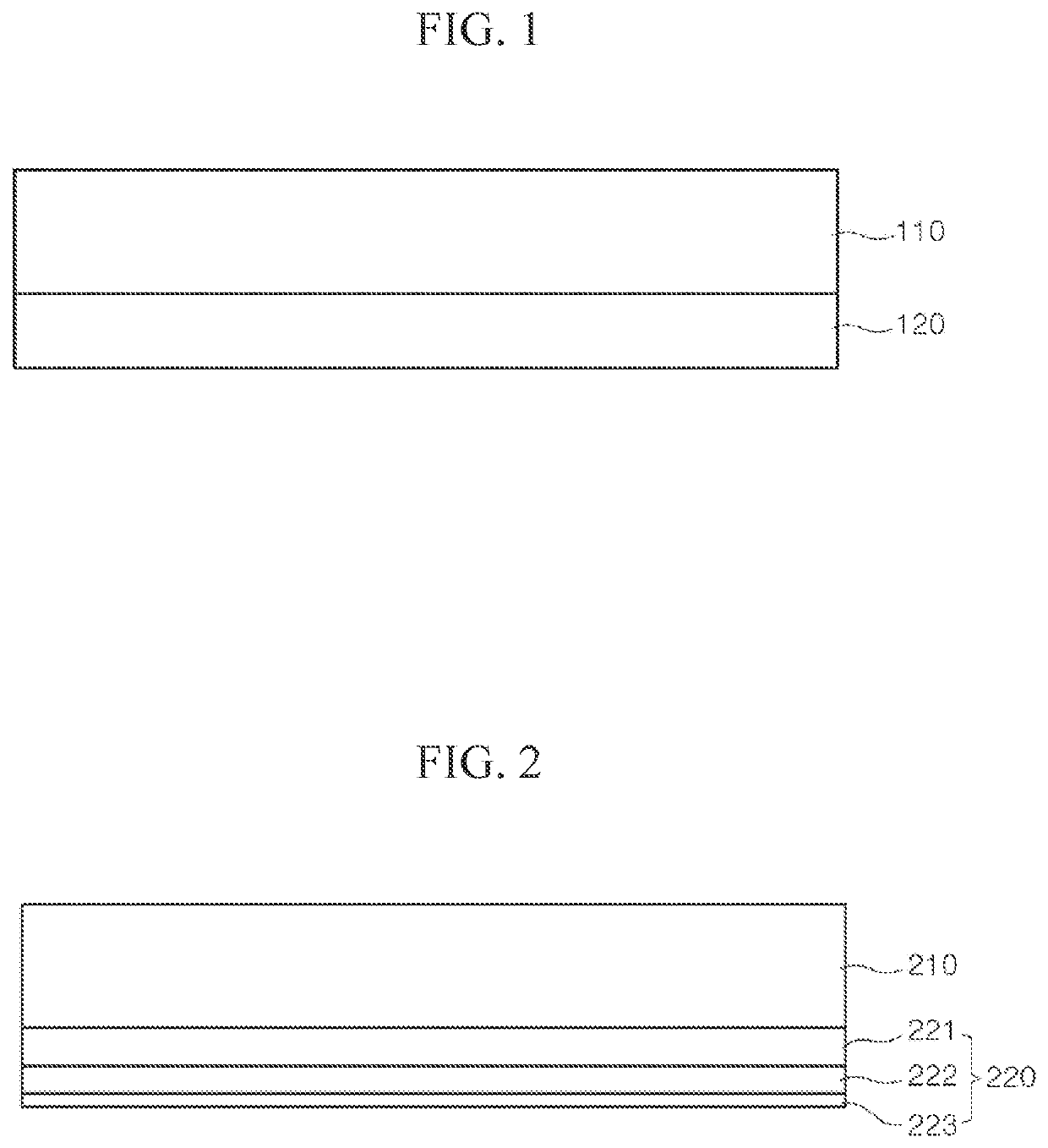Blankmask with backside conductive layer, and photomask manufactured with the same
- Summary
- Abstract
- Description
- Claims
- Application Information
AI Technical Summary
Benefits of technology
Problems solved by technology
Method used
Image
Examples
example 1
[0047]A conductive layer having a three-layer structure mainly made of Cr was formed on a backside of a SiO2-TiO2-based transparent substrate using DC magnetron reactive sputtering equipment. All of the first to third layers of the conductive layer were formed using a Cr target.
[0048]The first layer was formed of a CrCON film having a thickness of 41 nm by injecting Ar:N2:CO2=6 sccm:10 sccm:6 sccm as a process gas and using a process power of 1.4 kW. The second layer was formed of a CrCN film having a thickness of 30 nm by injecting Ar:N2:CH4=5 sccm:5 sccm:0.8 sccm as a process gas and using a process power of 1.0 kW. The third layer was formed of a CrCON film having a thickness of 9 nm by injecting Ar:N2:CO2=3 sccm:5 sccm:7.5 sccm as a process gas and using a process power of 1.4 kW.
[0049]As a result of measuring a sheet resistance of the conductive layer using a 4-point probe, a sheet resistance value was shown as 15.6 Ω / □, and when a surface roughness was measured by atomic force...
example 2
[0056]In Example 2, a composition of a second layer of a conductive layer was changed from CrCN to CrN. In order to form the second layer, a CrN film having a thickness of 32 nm was formed by injecting Ar:N2=5 sccm:5 sccm as a process gas and using a process power of 1.0 kW. Other processes are the same as in Example 1. As a result of measuring a sheet resistance of the conductive layer using a 4-point probe, a sheet resistance value was shown as 20.2 Ω / □, and when a surface roughness was measured by atomic force microscope (AFM), a surface roughness value was shown as 0.28 nm RMS. Therefore, it was confirmed that there is no problem in bonding with the electronic-chuck and there is no problem in using the conductive layer of Example 2 as the conductive layer.
[0057]When the flatness of the conductive layer was measured with a flatness meter, the value of 190 nm was obtained, and the stress was compressive stress. The flatness of the front side of the substrate after the process of f...
example 3
[0058]In Example 3, a composition of a first layer was changed from CrCON to CrCO. In order to form the first layer, a CrCO film having a thickness of 39 nm was formed by injecting Ar:CO2=6 sccm:6 sccm as a process gas and using a process power of 1.4 kW Other processes are the same as in Example 1. As a result of measuring a sheet resistance of a conductive layer using a 4-point probe, a sheet resistance value of 21.6 Ω / □ was shown, and when a surface roughness was measured by atomic force microscope (AFM), a surface roughness value of 0.27 nm RMS was shown. Therefore, it was confirmed that there is no problem in bonding with the electronic-chuck and there is no problem in using the conductive layer of Example 3 as the conductive layer.
[0059]When the flatness of the conductive layer was measured with a flatness meter, the value of 190 nm was obtained, and the stress was compressive stress. The flatness of the front side of the substrate after the process of forming the absorbing fi...
PUM
 Login to View More
Login to View More Abstract
Description
Claims
Application Information
 Login to View More
Login to View More - R&D
- Intellectual Property
- Life Sciences
- Materials
- Tech Scout
- Unparalleled Data Quality
- Higher Quality Content
- 60% Fewer Hallucinations
Browse by: Latest US Patents, China's latest patents, Technical Efficacy Thesaurus, Application Domain, Technology Topic, Popular Technical Reports.
© 2025 PatSnap. All rights reserved.Legal|Privacy policy|Modern Slavery Act Transparency Statement|Sitemap|About US| Contact US: help@patsnap.com

